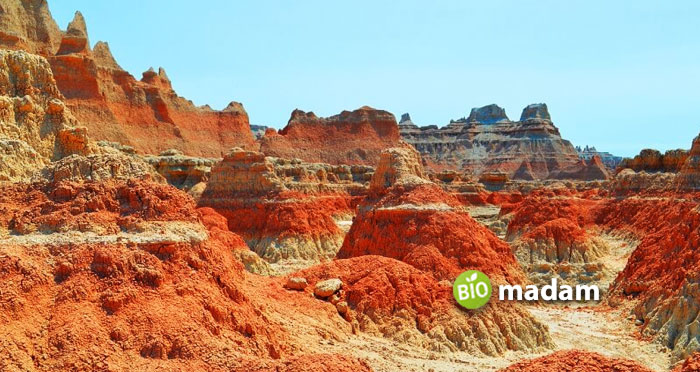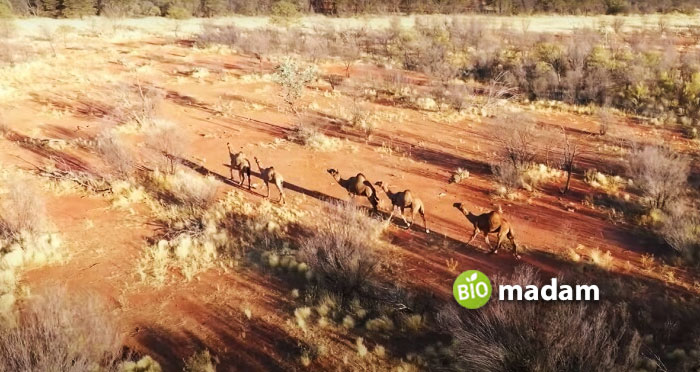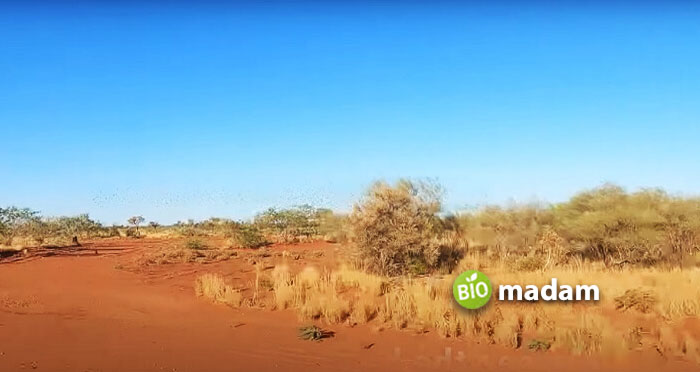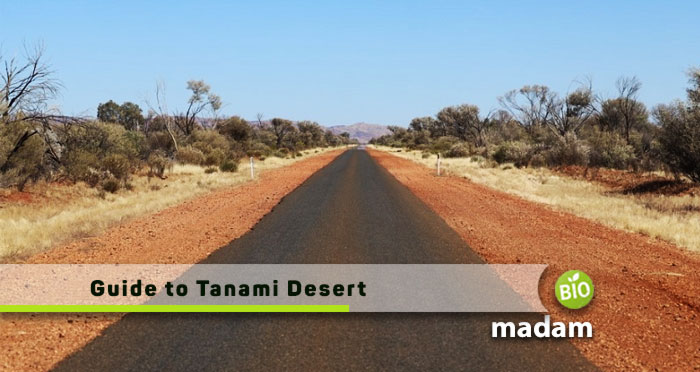Recently updated on February 18th, 2024 at 04:06 pm
Welcome to the wild and vast Tanami Desert in Australia, a rugged area that has been home to Indigenous communities for a long time. Situated in the heart of the Northern Territory Desert, this remote, unexplored, yet one of the largest deserts of Australia, is perfect for adventurous travelers who want to experience untouched nature and learn about Indigenous culture. In this guide, we will explore the wonders of the Tanami, from its extreme climate and impressive land formations to the diverse plant and animal life that survives in its dry plains and sand dunes.
Come with us as we set out to uncover the secrets of the Tanami Desert and understand how to explore this ancient land in a sustainable and respectful way. We’ll dive into the rich traditions of the Indigenous people, find hidden water sources, and see how life persists in this tough environment, turning every step into a deep exploration of nature and heritage.
Geographical Features
The Tanami Desert features vast plains of spinifex grasslands dotted with acacia shrubs and bloodwood trees. Subtle dunes and low ridges of red earth break up the flat terrain. Stony hills and rises occasionally emerge on the horizon. During wet periods, ephemeral lakes and swamps form, creating important wetlands like Lake Ruth and Sanctuary Swamp.
But the Tanami is primarily a sandy desert, with the spiky spinifex and hardy acacias adapted to the arid conditions. While it may seem desolate at first glance, the Tanami Desert has its own understated beauty, shaped by the forces of nature over time. Closer exploration reveals a landscape rich in life yet still retaining its remote and wild spirit.
Ethnic Culture and Communities
- Cultural Significance: The Tanami Desert is more than a barren landscape; it is a vibrant living cultural tapestry. Indigenous communities, including Yuendumu, Balgo, Billiluna, and the Warlpiri lands, contribute to the region’s rich and deep cultural heritage. Their traditions, stories, and practices are deeply intertwined with the vast expanse of the desert.
- Community Insights: To truly appreciate the Tanami’s essence, delve into the unique lifestyles and customs of the Indigenous communities that call this desert home. These communities are not merely settlements; they are gatekeepers of centuries-old traditions. Visit local Culture Centres, where elders share their wisdom, offering profound insights into the spiritual connection these communities maintain with the land.
- Artistic Expressions: The Tanami Desert is a canvas of artistic expressions, with Indigenous art playing a pivotal role in preserving cultural identity. Traditional paintings, storytelling, and performances showcase the vibrancy of this cultural heritage. Art is not just an aesthetic pursuit; it’s a means of transmitting ancestral knowledge, ensuring that the heartbeat of the desert continues to resonate through time.
- Warlpiri Lands: Among the significant contributors to the Tanami’s cultural fabric are the Warlpiri lands. These lands hold a special place in the Indigenous tapestry, harboring unique practices, Dreamtime stories, and a commitment to preserving and revitalizing Indigenous languages. Explore the heart of Warlpiri culture, where traditions are not only preserved but celebrated.
- Cultural Experiences: Engaging in cultural experiences enriches the Tanami journey. Guided tours led by Indigenous community members provide an opportunity to immerse yourself in the traditions of the land. Participate in traditional ceremonies, learn about bush tucker, and gain firsthand knowledge of the intricate relationship between the Indigenous communities and their environment. It is crucial to approach these experiences with respect, ensuring a meaningful and respectful cultural exchange that benefits both visitors and hosts alike.

Tanami Track and Road Conditions
The Tanami Track, a sandy traverse connecting Alice Springs to the Kimberley Region, serves as the gateway to the heart of the desert. Explore historical explorations into this remote expanse and take on the well-formed earth Tanami Track. But beware, this route demands a reliable 4WD vehicle, spare tires, and spare fuel. Discover points of interest along the way, including Tilmouth Well Station and the 650,000-acre Birds Australia’s Newhaven Sanctuary.
How Long Does It Take To Drive the Tanami Track?
As mentioned, the Tanami Track is over 1,000 km long. Driving the entire length of the track takes 2-3 days for most travelers. However, Tanami road conditions can vary greatly depending on the weather and time of year.
During the dry season from May to September, the track is usually firm and relatively smooth, allowing for faster speeds up to 80 km/hr in some sections. This would enable completing the route in 2 days or less if driven straight through. However, most choose to take 3 days in the dry season to allow for leisurely exploration.
In the wet season from November to March, heavy rains can cause sections of the track to become flooded, muddy, or deeply corrugated. Driving speeds may slow to 20-30 km/hr in poor conditions, increasing total drive times. Some sections may become impassable for days after heavy rain. The heat of summer can also be grueling.
No matter when you go, be sure to check recent track conditions and weather reports. Carry extra fuel, tires, and supplies in case of delays. Allow flexibility in your itinerary in case road conditions force slower speeds or detours. While the Tanami can be driven in 2 days in optimal conditions, a 3-4 day trip is recommended to ensure a safe and enjoyable journey.
Biodiversity and Conservation
Delve into the Tanami’s biodiversity, where hummock grasslands of soft spinifex meet acacia scrubland dotted with iconic bloodwood eucalypts. The landscape hosts a variety of rare or declining native species such as the greater bilby, brush-tailed mulgara, Australian bustard, and great desert skink. Conservation efforts aim to protect these threatened species and ecosystems. However, challenges persist from introduced predators like feral cats and foxes, grazing from invasive herbivores such as camels and rabbits, the spread of buffel grass, and the pressures of climate change. Ongoing programs strive to control pests, restore degraded habitats, and monitor ecosystems within protected areas.
National Reserve System
Over 14 million hectares of the Tanami Desert fall under the National Reserve System, showcasing a substantial commitment to conservation. The majority of this protected landscape is encompassed by the Northern Tanami and Southern Tanami Indigenous Protected Areas, serving as crucial havens for endangered flora and fauna. These reserves not only preserve the natural and cultural heritage but also reflect a collaborative approach to management. Traditional Aboriginal owners, scientists, and government agencies work together in feral animal control, fire management, species monitoring, and sustainable enterprise development. The success of these joint efforts across the National Reserve System is paramount for securing the future of the Tanami’s biodiversity.
Flora and Fauna of the Tanami Desert
The Tanami Desert is home to a diverse array of desert-adapted flora and fauna, each playing a unique role in its delicate ecosystem.
Tanami Desert Plants
- Spinifex Grasslands: Vast plains are covered by hummock grasslands of Triodia pungens soft spinifex, resilient tussock grasses thriving in arid sands.
- Acacia Shrublands: The landscape is dotted with various acacia species, including catclaw acacia and red mulga, providing vital habitat and food sources.
- Bloodwood Eucalypts: Corymbia opaca bloodwood trees add height and shade, particularly along drainage lines.
- Mulga Woodlands: Stretches of mulga (Acacia aneura) grow in red earth habitats.
- Ephemerals: Wildflowers like mulla mullas burst with color after rainfall.
Tanami Desert Animals
- Marsupials: Unique species such as bilbies, mulgaras, and rare black-footed rock wallabies inhabit the Tanami. However, predation poses a threat to many of these marsupials.
- Reptiles: Iconic Tanami reptiles include great desert skinks, bearded dragons, and thorny devils.
- Birds: The region is frequented by Australian bustards, budgerigars, wedge-tailed eagles, and honeyeaters.
- Invertebrates: A thriving diversity of spiders, including striking species like peacock spiders, coexists with important seed-dispersing camel crickets.

Mineral Resources and Tanami Desert Mines
The Tanami Desert is renowned for its wealth of mineral resources, with notable mines extracting precious elements that contribute significantly to the mining industry.
The Granites Gold Mine
One of the key players in the Tanami’s mineral landscape is The Granites Gold Mine. Nestled within the arid expanse, this mine extracts gold, a resource that has not only fueled the region’s mining industry but has also left an indelible mark on the economic landscape. The extraction of gold from This Tanami gold mine has been a driving force behind economic activities, supporting local communities and impacting the broader regional economy.
Coyote Gold Mine
Another noteworthy contributor to the mining industry in the Tanami Desert is the Coyote Gold Mine. Like The Granites, this mine is a hub of economic activity, extracting valuable gold resources from the heart of the desert. The Coyote Gold Mine stands as a testament to the region’s mineral wealth and its impact on sustaining livelihoods within the Tanami.
Climate and Weather
The Tanami Desert weather and climate are characterized by distinct wet and dry seasons. Here are the key features of the climate and weather in the Tanami Desert:
Temperature
Days in the Tanami Desert boil, the sun scorching the earth to over 40°C. Yet nightfall brings respite, as the Tanami Desert temperature range plunges under crystalline skies. This extreme fluctuation shapes life in the Tanami, from reptiles basking in daytime heat to bilbies emerging under cover of darkness. The desert’s rhythms pulse with the dramatic rise and fall of the thermometer.
Wet and Dry Seasons
While arid for most of the year, the Tanami awakens during the annual summer monsoon. From November to March, humid winds usher in the wet season. Concentrated downpours replenish ephemeral lakes and rouse dormant seeds. Brief, glistening green carpets the land. But as quickly as it came, the rain retreated, leaving clear blue skies. The desert returns to its typical parched state, where every drop of water remains precious.
Rainfall
Rain rarely falls in the Tanami, with annual averages of just 298mm. Yet when storms hit, the deluges rapidly flood parched creek beds in a violent spectacle. Water churns through the desert, breaching red earth banks, before gradually evaporating under the relentless sun. These isolated downpours are lifelines, satiating animals, and plants adapted to hold every last drop. But rainfall patterns shift unpredictably, keeping the desert in a delicate balance.
Monsoonal Influence
The Australian monsoon sets the rhythm of the Tanami’s seasons. Humid tropical air arrives between November and March, interacting with weather systems over the desert. The monsoon ushers in the timings of rains, altering the intensity of downpours. Reading the monsoon’s fluctuations is key to predicting the Tanami’s cycles of boom and bust.
Extreme Temperatures
The Tanami bakes under the blazing summer sun, testing the limits of all life. Daytime highs above 40°C push reptiles and birds into shade, while smaller mammals burrow underground. But as the searing sun sets, temperatures rapidly cool off under night skies glittering with stars. This extreme temperature range shapes unique desert ecosystems remarkably adapted to both heat and cold.
Water Scarcity
In the Tanami, water dictates survival. Average annual rainfall seeps rapidly into the earth while ephemeral lakes only occasionally hold rainwater. Finding precious liquid sustenance falls upon plants, animals, and people dwelling in this parched landscape. Clever adaptations like water-storing bulbous roots allow life to flourish, so long as the rains eventually return.
Preparedness
Entering the Tanami requires respect for the harsh environment. Carry ample water and fuel supplies and utilize vehicles suited for the terrain. Seek shade during the hottest parts of the day. Know that plans may change around water availability and local conditions. Preparation and flexibility allow for safer travel through a desert known for both beauty and hardship.
How Tourists Can Explore the Tanami Desert?
Embarking on an adventure in the Tanami Desert offers a unique and rugged experience. To ensure a safe and enjoyable exploration, here’s a guide for tourists:

Vehicle Readiness
- 4WD Vehicles: Utilize a reliable 4WD vehicle equipped with spare tires and sufficient fuel. The terrain can be challenging, and a 4WD ensures better navigation through gravel roads and sandy tracks.
- Mechanical Check: Before the journey, thoroughly inspect your vehicle. Ensure tires, brakes, and the engine are in optimal condition to prevent breakdowns in the remote desert.
Essentials for the Journey
- Ample Supplies: Carry enough fuel, food, and water, as services may be limited along the way. Some roadhouses can be unreliable, making self-sufficiency crucial.
- Emergency Provisions: Pack a comprehensive emergency kit, including a first aid kit, spare tires, and tools. The vastness of the desert may limit immediate assistance.
Camping and Accommodation
- Campsites: Identify designated camping sites along the Tanami Track. Follow Leave No Trace principles to minimize environmental impact.
- Accommodation: Consider staying at roadhouses or designated accommodations like Tilmouth Well Station for a more comfortable experience.
Cultural Respect
- Indigenous Communities: The Tanami Desert is home to Indigenous communities with rich cultural heritage. Seek permission before entering specific areas and visit cultural centers in communities like Yuendumu, Balgo, and Billiluna.
Permits and Regulations
- Camping Permits: Some areas may require camping permits. Obtain these permits from relevant offices in Mulan and Billiluna.
- Adherence to Regulations: Respect conservation and land management regulations to preserve the desert’s fragile ecosystem.
Wildlife and Nature Appreciation
- Bird Watching: Explore the diverse birdlife around Lake Gregory, known for over 73 varieties of waterbirds. Obtain permits for birdwatching activities from the Paruku IPA offices.
- Flora and Fauna Observation: Enjoy the unique flora and fauna of the Tanami by following designated tracks and being mindful of the delicate desert environment.
Weather Awareness
- Temperature Considerations: Be aware of the extreme temperatures, especially during the summer. Carry enough water, wear appropriate clothing, and plan activities for cooler parts of the day.
Safety First
- Emergency Communication: Carry a satellite phone or emergency beacon for communication in case of emergencies. Mobile reception can be limited or nonexistent in some areas.
- Inform Others: Share your travel plans with someone, including your expected routes and return times.
Wrapping Up – How Big Is the Tanami Desert?
As you conclude your Tanami Desert adventure, appreciate the vastness of this remarkable landscape. Covering 184,500 square kilometers (71,235 square miles), the Tanami Desert stands as Australia’s third-largest, after the Great Victoria Desert and the Great Sandy Desert. This expansive wilderness narrates a tale of survival shaped by the forces of nature over time. Delving into its dimensions adds another layer to the awe-inspiring journey you’ve undertaken. Bid farewell to the untamed beauty of the Tanami, carrying the echoes of your experience as a guide back to its heart. Safe travels!

As a freelance journalist, copywriter, and editor, Rachel Truman crafts compelling stories across travel, food, family, lifestyle, and B2B. With a keen eye for detail, Rachel specializes in creating engaging branded content, making every word an adventure

